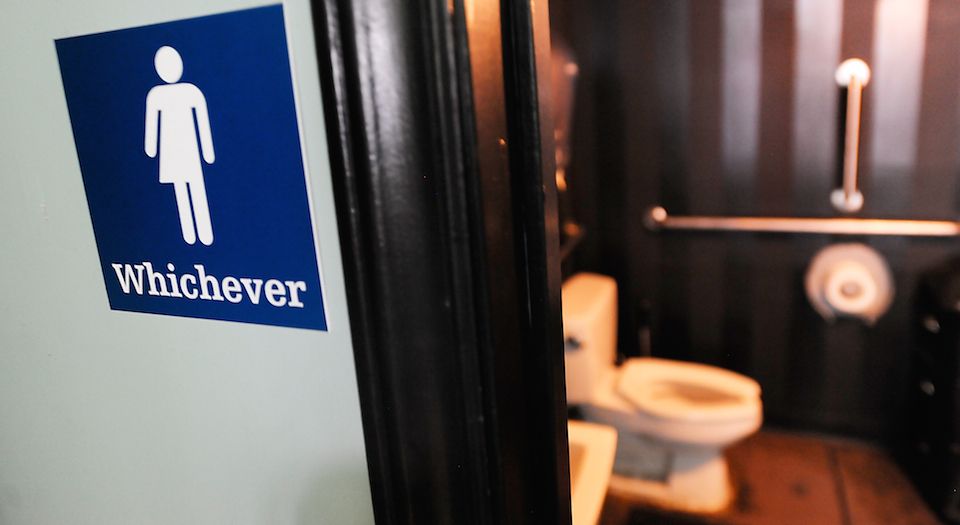
Long-read
The prison-house of gender
Contemporary feminist ideas of gender restrict rather than liberate women.
Want to read spiked ad-free? Become a spiked supporter.
For centuries, philosophers have been preoccupied by the question of what it is to be a woman. Differences between the sexes were first understood as natural, with women defined in opposition to men. Aristotle considered women to be ‘deformed males’; he claimed, ‘the male is by nature superior and the female inferior’. This finds a later echo in the Biblical story of God fashioning woman from the ribs of man.
For millennia, then, biological differences between men and women have been used to naturalise inequalities in social status; men are ‘by nature’ dominant, just as women are naturally nurturing. Rousseau argued that inequality in the state of nature explained contemporary differences between men and women. This led him to the view that boys and girls should be educated differently: ‘Give, without scruples, a woman’s education to women, see to it that they love the cares of their sex, that they possess modesty, that they know how to grow old in their menage and keep busy in their house.’ In the 20th century, anthropologists such as Claude Levi-Strauss similarly argued that the position of women in society was down to the historical impact of biological differences between the sexes. Today these arguments persist, but they have been relocated from the body to the brain. Perhaps unsurprisingly, the conclusions remain the same: women’s brains make them more nurturing and better suited to caring roles.
Today, the view that sex differences can be located in biology rubs up against a more dominant narrative that gender is socially constructed, non-binary and fluid. Facebook famously offers over 50 gender options for people to choose from; students declare their preferred gender pronouns; and even very young children describe themselves as transgender. Yet there appears to be little that is liberatory about this apparent freedom from biology. Instead, new orthodoxies entrench conservative attitudes about the ‘correct’ behaviour and appearance for those who identify as boys or girls. It seems that we are no nearer to answering the question of what it is to be a woman.
The view that, for women, biology is destiny was first called into question by the Enlightenment philosopher, Mary Wollstonecraft. In A Vindication of the Rights of Women, published in 1792, Wollstonecraft takes Rousseau to task. She criticises the way women of her day conducted themselves but, she contends, their attitudes and behaviour are not a product of their innate disposition. She argues that education, far from responding to pre-existing biological differences, actually helps create differences between the sexes. Women are not born as such inferior beings, Wollstonecraft suggests, but are brought up to become ‘more artificial, weak characters than they would otherwise have been’. Their education and upbringing prevent women from having ‘sufficient strength of mind to acquire what really deserves the name virtue’. Wollstonecraft is clear that endeavouring to keep women ‘always in a state of childhood’ degrades both men and women. She proposes we ‘strengthen the female mind by enlarging it’, and only then will there ‘be an end to blind obedience’.
Wollstonecraft does not argue that men and women are equal or that there are no differences between the sexes. Rather, she insists that the contemporary status of women is a result of the way women are treated: ‘Men have increased that inferiority till women are almost sunk below the standard of rational creatures.’ Similarly, she is scornful of the idea that women are naturally more gentle and nurturing than boys: ‘The doll never excites attention unless confinement allows her no alternative.’ Wollstonecraft argues that women are ‘made’ through the different and impoverished environment females are afforded, and this in turn has an impact upon their biology. ‘False notions of beauty and delicacy’, she writes, ‘stop the growth of their limbs and produce a sickly soreness’. Wollstonecraft poses a revolutionary question: how can women ‘attain the vigour necessary to enable them to throw off their factitious character’? It is only when women are freed from the social restraints placed upon them that both men and women alike will be able to realise their potential as rational beings.
Over 150 years later, the French philosopher Simone de Beauvoir picked up and built on Wollstonecraft’s ideas. In tandem with her lifelong partner Jean Paul Sartre, de Beauvoir pioneered a new philosophy of existentialism. In her 1949 book, The Second Sex, de Beauvoir applies existentialist ideas to the question of what it is to be a woman. She mocks attempts to reduce women to their biology: ‘Woman? Very simple, say the fanciers of simple formulas: she is a womb, an ovary; she is a female – this word is sufficient to define her.’ And de Beauvoir agrees with Wollstonecraft that education and upbringing help render girls inferior by indoctrinating them into their future vocation as women.
De Beauvoir is, however, critical of ‘the philosophy of the Enlightenment, of rationalism, of nominalism’. She argues that this approach sees the word woman as having no specific content, and women as ‘merely the human beings arbitrarily designated by the word woman’. To de Beauvoir, differences between men and women are perhaps ‘superficial’ or ‘destined to disappear’, but ‘what is certain is that they do most obviously exist’. Her philosophical approach allows her neither biological nor purely environmental explanations for this conclusion.
The body, as a physical entity, fascinates the existentialist de Beauvoir. She asserts that ‘in girls, as in boys, the body is first of all the radiation of a subjectivity, the instrument that makes possible the comprehension of the world: it is through the eyes, the hands, that children apprehend the universe, and not through the sexual parts’. Her argument is that the existence of a female body precedes the essence of a woman, asserting, most famously, that ‘one is not born but rather becomes a woman’. This is not to suggest that women are simply a product of their circumstances. De Beauvoir argues instead that ‘every female human being is not necessarily a woman; to be so considered she must share in that mysterious and threatened reality known as femininity’. The crucial phrase here is ‘she must share’. De Beauvoir suggests that females play an active part in constructing themselves as women. She criticises women who practice ‘bad faith’ and refuse to accept responsibility for their lives.
De Beauvoir’s privileging of a woman’s individual agency in determining her destiny is a retort to biological constructions of womanhood: ‘It is not nature that defines woman; it is she who defines herself by dealing with nature on her own account in her emotional life.’ This privileging of agency is just as much a challenge to the argument that women are made by society. Of course, de Beauvoir was not blind to the difficulties women faced in assuming responsibility for their own destiny: a woman is ‘treated like a live doll and refused liberty’, she declaimed, ‘thus a vicious circle is formed; for the less she exercises her freedom to understand, to grasp and discover the world about her, the less resources will she find within herself, the less will she dare to affirm herself as subject’. However, de Beauvoir stresses the choices a woman does have: ‘I believe that she has the power to choose between the assertion of her transcendence and her alienation as object.’
The distinction de Beauvoir draws between being born female and becoming a woman hints at what the psychologist John Money was first to define, in 1955, as a distinction between biological sex, or the physical attributes that distinguish male and female, and gender – the behaviour and roles that a person experiences and expresses. Up until this point, the word ‘sex’ was used to describe a person’s physical body and their sense of identity without any distinction being made between the two. But during the 1960s and especially the 1970s, feminists popularised the word ‘gender’ through their questioning of the rigid differentiation between roles for men and women. Neither de Beauvoir, nor those who first defined gender, sought to deny the underlying biological reality of a person’s sex. But they suggested that the way in which this biological fact was enacted was socially constructed. As Germaine Greer explains, ‘female might be essence and feminine social construct’.
Gender as a social construct
The American philosopher and gender theorist, Judith Butler, explores the idea of gender as a social construction or a ‘performance’ in her 1990 book Gender Trouble. Butler criticises the idea that men and women once existed in a state of nature on the grounds that it propagates and justifies a simplistic understanding of sex. ‘This recourse to an original or genuine femininity’, she writes, ‘is a nostalgic and parochial ideal that refuses the contemporary demand to formulate an account of gender as a complex cultural construction’. Rather than this argument being used to delineate a ‘natural’ female from a ‘social’ woman, Butler goes a step further and argues that the very concept of biological sex differences ‘is a discursive formation that acts as a naturalised foundation for the nature/culture distinction and the strategies of domination that the distinction supports’.
In Butler, feminism meets post-structuralism. She questions the existence of a binary concept of ‘natural’ sex preceding and underpinning an ‘artificial’ gender. Rather than being a fixed category, whether socially or naturally determined, Butler sees gender as a fluid concept that is defined only in relation to what it is not; it is ‘a complexity whose totality is permanently deferred’. Just as gender cannot be counterposed to sex, neither can man be counterposed to woman. Butler wants to move away from ‘the presumption of a binary gender system’, which she considers ‘implicitly retains the belief in a mimetic relation of gender to sex whereby gender mirrors sex or is otherwise restricted by it’. She argues, ‘there is no gender identity behind the expressions of gender’. To this end, Butler sees gender as ‘always a doing’ rather than a fixed position.
The consequences of the rejection of the concept of sex are significant and represent far more than just the abandonment of a biological category considered to be outdated. Butler claims gender is ‘always a doing’ and as such is located not in culture, biology or society but in performance. However, Butler goes on to add an important proviso; that this performance is ‘not a doing by a subject who might be said to preexist the deed’. Butler turns de Beauvoir’s existentialism upside down: rather than a person, de Beauvoir’s self-determining woman, acting out femininity, it is the action, the act of performance, that creates the gendered subject. Butler refuses to ‘postulate a femininity that is prior to mimicry and the mask’; instead, she argues, ‘authentic womanliness is such a mimicry, is the masquerade’.
For Butler, the chief location for the performance of gender is sexuality. She asks: ‘How do certain sexual practices compel the question: what is a woman, what is a man?’ She argues it is not society in general but heterosexuality in particular that positions women as subordinate to men. Indeed, ‘to have a gender means to have entered already into a heterosexual relationship of subordination’. It is through the performance of sexuality that the gendered subject is constructed and through the ‘doing’ of heterosexuality that women become lesser than men. Butler suggests heterosexuality has become ‘naturalised,’ even ‘compulsory’ and the policing of heterosexuality regulates gender as a binary male/female construct. Butler’s answer to the question ‘what is a woman?’ is a being who performs a submissive position within a heterosexual framework. The extent to which this view of gender has become widely accepted can be seen in the current preoccupation with sexual harassment and ‘rape culture’. For Butler, ‘sexual harassment is the paradigmatic allegory for the production of gender… The act of harassment may be one in which a person is “made” into a certain gender.’
Butler’s work takes us a long way from the thinking of both Wollstonecraft and de Beauvoir. All three challenge a purely biological understanding of what it means to be a woman. We can no longer explain the historical oppression of women in relation to a mythical state of nature and we are forced to look at the role of education, the family, the workplace and society in creating gender relations as we understand them. Yet, whereas for de Beauvoir, women play an active role in the construction of their gendered behaviour, for Butler there is no such agent able to do the constructing. Instead of a woman performing gender and ‘making’ herself, the woman is ‘made’ through a performance she is coerced into.
Butler’s rejection of any connection between biology and gender, and with it a rejection of male and female as binary opposites, can appear, on the surface, to be liberatory. People are now freed from the supposedly oppressive tyrannies of biology and society. People no longer have to comply with convention or fit into neat categories: we can identify as any one of 50-plus different genders. However, this fluidity comes at a price. Unlike feminists such as de Beauvoir and Greer, for whom the shift from sex to gender emphasised a woman’s agency, Butler’s de-biologising of gender renders women passive. They are not in control of who they are or how they act – indeed, there is no ‘they’ at all prior to the sexual performance. Butler’s women may not be biologically female but, in return, they must spend time gazing inwards, ascertaining the ‘innate feeling’ that comes with their performance and bringing this in line with their self-declared identity and preferred pronouns.
Ultimately, in contrast to Wollstonecraft’s desire to liberate women from the stifling social conventions that left them intellectually impoverished and irrational, Butler imposes a new gender tyranny. We may be able to define ourselves in a multitude of different ways, but our life’s work becomes thinking about our feelings towards our body and researching our gender identity. The further we move away from any connection between sex and either biology or society, the more individuals require public affirmation that they are who they say they are. It is no longer enough to be a woman; you also need recognition from other people that this is, indeed, who you are; and you need to have your gendered performances confirmed in the public arena. It is for this reason that dress and public lavatories are such an important focus for transgender people. Through such mundane aspects of our everyday life, gender is performed, asserted and publicly endorsed. This concept of gender, which so diverges from the emancipatory ideas of Wollstonecraft and de Beauvoir, emerges from and reinforces identity politics. It’s now our differences that define us. As Butler declares, ‘I tend to conceive of the claim of “universality” in exclusively negative and exclusionary terms’.
In 1992, the sociologist Anthony Giddens wrote: ‘Where large areas of a person’s life are no longer set by pre-existing patterns and habits, the individual is continually obliged to negotiate lifestyle options. Moreover such choices are not just “external” or “marginal” aspects of the individual’s attitudes, but define who the individual “is”. In other words, lifestyle choices are constitutive of the reflexive narrative of the self.’ This ‘narrative of the self’ emphasises how the performance of gender must be an ongoing process of self-construction. This is worse than just boring; it also traps us within ourselves. Far from being liberated, we become imprisoned by our own need to assert our identity. A far more radical and progressive message comes from de Beauvoir who declared: ‘I am interested in the fortunes of the individual as defined not in terms of happiness but in terms of liberty.’
Joanna Williams is education editor at spiked, and the co-editor of Why Academic Freedom Matters, published this month by Civitas. It is available to download for free here.
Picture by: Getty Images.
Who funds spiked? You do
We are funded by you. And in this era of cancel culture and advertiser boycotts, we rely on your donations more than ever. Seventy per cent of our revenue comes from our readers’ donations – the vast majority giving just £5 per month. If you make a regular donation – of £5 a month or £50 a year – you can become a and enjoy:
–Ad-free reading
–Exclusive events
–Access to our comments section
It’s the best way to keep spiked going – and growing. Thank you!







Comments
Want to join the conversation?
Only spiked supporters and patrons, who donate regularly to us, can comment on our articles.